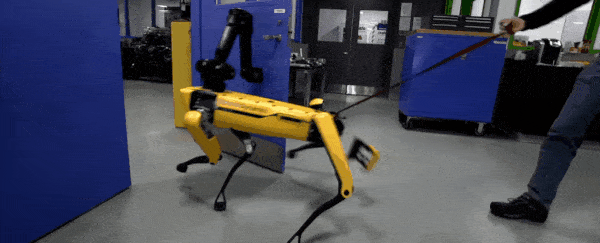In one of the scariest moments in the movie Jurassic Park, a pair of intelligent Velociraptors, brought back to Earth by man's hubris, defy an assumption about their limitations: They open a kitchen door.
Now imagine that the raptors are real, transformed into headless robot dogs that can negotiate stairs, fling open doors with their robotic claws and generally overcome the puny obstacles offered up by the human technicians at Boston Dynamics.
The robotics company posted a video last week, showing two of their yellow SpotMini robots helping each other enter a door.
Now the company has released a sequel in which a single 2.5-foot-tall (75 cm robot) robot is controlled by an unseen human driver who directs the robot claw to the door handle and issues a "Go" command.
From then on, the SpotMini's camera-guided, autonomous programming kicks in to fulfill its mission to open the door.
Besides providing nightmare fuel for humankind, and plotlines for the bleak tech world TV show Black Mirror, the robots could also offer more positive benefits.
During a natural or human-made disaster, for instance, they could help navigate situations that would otherwise put people in danger (think inspecting gas leaks or clawing through rubble in a bombed-out building).
(The SpotMini's bulkier cousin, BigDog, was funded by the Pentagon's research arm as a potential battlefield ally to carry heavy ammunition and help evacuate wounded troops. But the Marine Corps decided in 2015 that BigDog was simply too loud and could give away the position to enemy troops.)
In the newest video, the SpotMini's claw is temporarily thwarted by a man using a wooden tool carried by Homo sapiens in Canada and the northeastern United States - a hockey stick.
The man then presses on the door to prevent the SpotMini from passing through, and when that fails, he yanks on a strap on the robot's rear, twisting its metal joints, which pivot for torque on the slick floor.
But SpotMini is prepared for such attacks. Its software adjusts the legs and body when pushed off balance, a company summary of the video said. The robot dog then rises to the occasion and gets through the door, though the viewer does not know what waits for it on the other side.
Boston Dynamics did not return a request for comment on the video release. The company, owned by Japan's SoftBank Group, is part of Japan's investment in robotics as the population ages and there's greater demand for elder care and other aid for seniors.
In the earlier, February 12 video, two SpotMinis apparently navigate the same obstacle.
A clawless SpotMini approaches the door, analyses its position with cameras studded on its frame, and makes way for a clawed colleague to open the door. In a show of digital chivalry, the second robot even politely holds the door for the other one to enter.
That video blazed across social media, with 8.3 million views in nine days of what history might someday record as dire warnings. (Mike Issac, a New York Times technology reporter, offered a contrarian take. "The robot dog is a good boy," he wrote on Twitter.)
This is not the first time the hockey stick was used to taunt Boston Dynamics robots. Another popular video published last February shows the company's researchers poking the humanoid robot Atlas as it tries to pick up and move boxes on the ground.
That's cute, because nine months later, Atlas showed off its back flip.
Perhaps these humanlike advancements provide a clue for why the newest video carries a disclaimer on YouTube: (Note: This testing does not irritate or harm the robot.)
It is a notable addition, though possibly made too late. These robots are designed to learn from their obstacles, and it seems the greatest obstacles so far are humans, not doors.
Humans program them with memory. The robots, therefore, cannot help but remember when a human might stand in its way.
2018 © The Washington Post
This article was originally published by The Washington Post.
